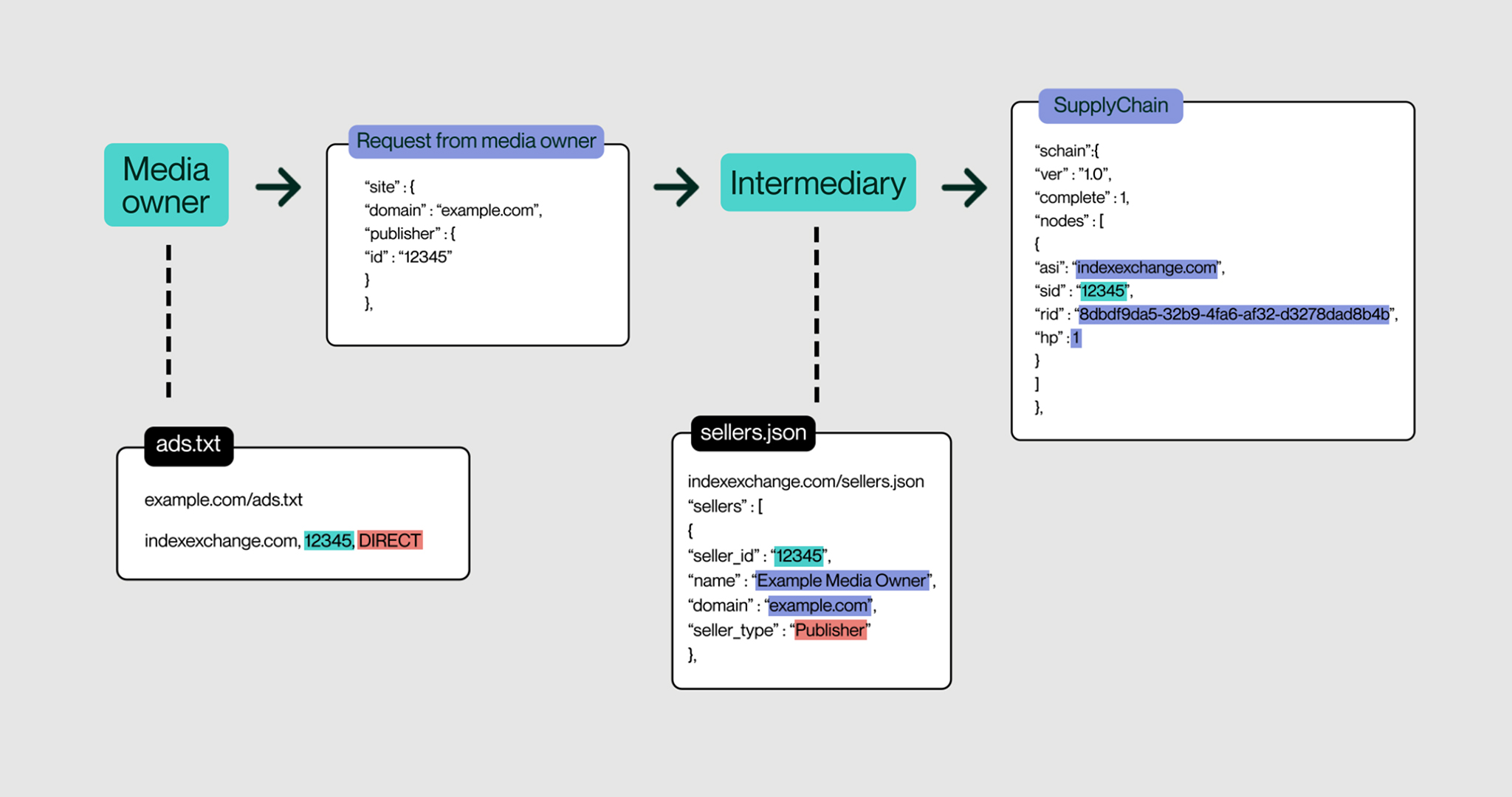The importance of supply chain transparency across the programmatic ecosystem
Supply chain transparency ensures brand safety, promotes inventory quality, and prevents malicious actors from infiltrating the programmatic supply chain. Let’s look at how industry specifications enable supply chain transparency in programmatic.
IAB Tech Lab has published three standards—Authorized Digital Sellers or ads.txt, sellers.json, and SupplyChain object—to address transparency. These standards help safeguard programmatic campaigns and provide vital information about the sellers of a media owner’s ad inventory.
More importantly, when connected, they provide a full trace of every participant and every media dollar in a given transaction down to the individual publisher. These tools are meant to be used together to see a full picture of transparency across the supply chain, yet they have distinctive purposes.
Let’s start with Authorized Digital Sellers, which includes ads.txt and app-ads.txt. These are publicly accessible files allowing media owners to declare which sellers are authorized to sell their digital ad inventory. By listing authorized seller IDs, ads.txt helps buyers avoid spoofed inventory and ensures that they are buying from only authorized, approved sources.
In streaming TV, there’s an added layer of complexity because of the many ways media owners can distribute their content to consumers under inventory sharing agreements. To address these relationships, the IAB Tech Lab released an enhanced version of app-ads.txt designed specifically for streaming TV.
Next is sellers.json, which is a publicly available list maintained by an SSP or an intermediary that aims to provide transparency about all the entities allowed to sell digital ad inventory on their respective platforms. It lists each seller’s name, domain, and role—such as publisher or intermediary—and thus allows buyers to verify the legitimacy of the seller or reseller and their position in the supply chain.
Finally, there is SupplyChain object, or schain, which details the complete transaction path for each bid request, from the original media owner to the final buyer. By including all entities involved in the selling or reselling process, this specification ensures that buyers can verify the legitimacy of each participant in the transaction chain.
How to use these supply chain transparency tools
Let’s walk through some examples of how these tools strengthen supply chain transparency.
Media owners will host their ads.txt file publicly, and you can typically access them by adding /ads.txt to their domain, like publisher.com/ads.txt.
This file will list all authorized sellers of their inventory. The information for each seller will include the seller’s domain, their seller ID, and the relationship the seller has with the media owner. For example, an authorized seller would appear as: indexexchange.com, 12345, DIRECT.
This seller information is passed in the bid request so downstream partners can verify that the supply they are receiving is authorized using the ads.txt file. This bid request is passed to the SSP or intermediary who will add their schain node to identify that they are involved in the sale of the impression opportunity.
The schain will contain their own domain, the seller ID, and other identifying information. The seller ID should match the ID number that is hosted in the media owner’s ads.txt file. Finally, the intermediary will host their own sellers.json file that lists all of the supply available on their platform. Within this file, the media owner should be listed with their company name, domain, seller ID, and inventory type.
We can match this information to the media owner’s ads.txt file. The seller IDs should match, and if the listing is “direct,” the sellers.json entry should indicate “publisher” or “both.” In the case of reseller lines in ads.txt, the sellers.json entry would read “intermediary.”

Now, what does it look like in the case of an unauthorized domain?
In this case, when we try to match the IDs passed in the bid request, we would find mismatches. This can occur at any place in the process. When we check the ID passed from the intermediary, it should be present on the ads.txt file. If it is missing, the seller is not authorized. There may be scenarios where the ID matches to a different seller in the ads.txt file. This could indicate that the intermediary is sourcing from an indirect source, not directly from the publisher.
You also want to closely evaluate the schain to validate that an impression is not going through too many hops in the supply chain as you can see in this example. As you get further from the inventory, you reduce efficiency and introduce more risk by not knowing who’s involved in selling an impression.
How ads.txt, sellers.json, and SupplyChain object work together
As each of these tools are distinct and different parties maintain these files, cross-referencing ads.txt, sellers.json, and SupplyChain provides the full picture that will help any buyer validate each step in the supply chain, ensure every seller is authorized, and identify any discrepancies.
Ads.txt allows media owners to declare sellers that are authorized to sell their ad inventory, but it doesn’t disclose the full supply path for each available ad opportunity, including any authorized intermediaries and resellers.
SupplyChain and sellers.json go a step further, enabling SSPs to declare all parties involved in selling a media owner’s ad inventory, and identify sellers at the root publisher level rather than solely at the domain level. Referencing sellers.json allows you to transparently track the payees behind ad impressions and see exactly where the money is going.
Note that while this can be a manual check, many platforms have automated parts of this process for added efficiency. We encourage you to explore tools and solutions with your partners to help make this process more efficient and validate a statistically significant sample of traffic for each seller.
Ads.txt, sellers.json, and SupplyChain are essential to fostering a safe and transparent programmatic marketplace. Correct implementation of these standards, as well as ongoing usage to verify transactions, will maximize safety for buyers and yield for media owners.
Learn more about our commitment to supply chain quality at Index Exchange.











